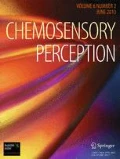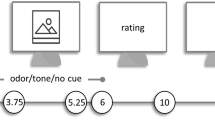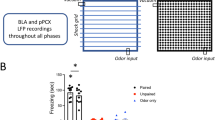Abstract
The current conceptualization of threat processing in anxiety emphasizes emotional hyper-reactivity, which mediates various debilitating symptoms and derangements in anxiety disorders. Here, we investigated olfactory sensory perception of threat as an alternative causal mechanism of anxiety. Combining an event-related functional magnetic resonance imaging paradigm with an olfactory discrimination task, we examined how anxiety modulates basic perception of olfactory threats at behavioral and neural levels. In spite of subthreshold presentation of negative and neutral odors, a positive systematic association emerged between negative odor discrimination accuracy and anxiety levels. In parallel, the right olfactory primary (piriform) cortex indicated augmented response to subthreshold negative (vs. neutral) odors as a function of individual differences in anxiety. Using a psychophysiological interaction analysis, we further demonstrated amplified functional connectivity between the piriform cortex and emotion-related regions (amygdala and hippocampus) in response to negative odor, particularly in anxiety. Finally, anxiety also intensified skin conductance response to negative (vs. neutral) odor, indicative of potentiated emotional arousal to subliminal olfactory threat in anxiety. Together, these findings elucidate exaggerated processing of olfactory threat in anxiety across behavioral, autonomic physiological, and neural domains. Critically, our data emphasized anxiety-related hyper-sensitivity of the primary olfactory cortex and basic olfactory perception in response to threat, highlighting neurosensory mechanisms that may underlie the deleterious symptoms of anxiety.



Similar content being viewed by others
References
Abraham A, Mathai KV (1983) The effect of right temporal lobe lesions on matching of smells. Neuropsychologia 21:277–281
Adolphs R, Damasio H, Tranel D, Damasio AR (1996) Cortical systems for the recognition of emotion in facial expressions. J Neurosci 16:7676–7687
Ahs F, Pissiota A, Michelgard A, Frans O, Furmark T, Appel L, Fredrikson M (2009) Disentangling the web of fear: amygdala reactivity and functional connectivity in spider and snake phobia. Psychiatry Res: Neuroimaging 172:103–108
Anderson AK, Christoff K, Panitz D, Ghahremani DG, Glover G, Gabriele JDE, Sobel N (2003) Dissociated neural representations of intensity and valence in human olfaction. Nat Neurosci 6:196–202
Ashburner J (2007) A fast diffeomorphic image registration algorithm. Neuroimage 38:95–113
Bensafi M, Rouby C, Farget V, Bertrand B, Vogouroux M, Holley A (2002) Psychophysiological correlates of affects in human olfaction. Clin Neurophysiol 32:326–332
Berle D, Phillips ES (2006) Disgust and obsessive compulsive disorder: an update. Psychiatry 69:228–238
Blanchard DC, Blanchard RJ (1988) Ethoexperimental approaches to the biology of emotion. Ann Rev Psychol 39:43–68
Borod JC, Cicero BA, Obler LK, Welkowitz J, Erhan HM, Santschi C, Grunwald IS, Agosti RM, Whalen JR (1998) Right hemisphere emotional perception: evidence across multiple channels. Neuropsychology 12:446–458
Carmichael ST, Clugnet MC, Price JL (1994) Central olfactory connections in the Macaque monkey. J Comp Neurol 346:403–434
Cox RW (1996) AFNI: software for analysis and visualization of functional magnetic resonance images. Comput Biomed Res 29:162–173
Davidson RJ, Irwin W (1999) The functional neuroanatomy of emotion and affective style. Trends Cogn Sci 3:11–21
Dilger S, Straube T, Mentzel HJ, Fitzek C, Reichenbach J, Hecht H, Krieschel S, Gutberlet I, Miltner WHR (2003) Brain activation to phobia-related pictures in spider phobic humans: an event-related functional magnetic resonance imaging study. Neurosci Lett 348:29–32
Dunsmoor JE, Prince SE, Murty VP, Kragel PA, LaBar KS (2011) Neurobehavioral mechanisms of human fear generalization. Neuroimage 55:1878–1888
Edelman RE, Chambless DL (1993) Compliance during sessions and homework in exposure-based treatment of agoraphobia. Behav Res Ther 31:767–773
Etkin A, Klemenhagen KC, Dudman JT, Rogan MT, Hen R, Kandel ER, Hirsch J (2004) Individual differences in trait anxiety predict the response of the basolateral amygdala to unconsciously processed fearful faces. Neuron 44:1043–1055
Flykt A, Esteves F, Ohman A (2007) Skin conductance responses to masked conditioned stimuli: phylogenetic/ontogenetic factors versus direction of threat? Biol Psychol 74:328–336
Friston KJ, Buechel C, Fink GR, Morris J, Rolls E, Dolan RJ (1997) Psychophysiological and modulatory interactions in neuroimaging. Neuroimage 6:218–229
Gottfried JA (2006) Smell: central nervous processing. Adv Otorhinolaryngol 63:44–69
Gottfried JA, Zald DH (2005) On the scent of human olfactory orbitofrontal cortex: meta-analysis and comparison to non-human primates. Brain Res Rev 50:287–304
Holmes A, Simon MK, Green S (2008) Effects of anxiety on the processing of fearful and happy faces: an event-related potential study. Biol Psychol 77:159–173
Jones-Gotman M, Zatorre RJ (1993) Odor recognition memory in humans: role of right temporal and orbitofrontal regions. Brain Cogn 22:182–198
Kanwisher N, McDermott J, Chun MM (1997) The fusiform face area: a module in human extrastriate cortex specialized for face perception. J Neurosci 17:4302–4311
Kats LB, Dill LM (1998) The scent of death: chemosensory assessment of predation risk by prey animals. Ecoscience 5:361–394
Krolak-Salmon P, Henaff MA, Vighetto A, Bertrand O, Mauguiere F (2004) Early amygdala reaction to fear spreading in occipital, temporal, and frontal cortex: a depth electrode ERP study in human. Neuron 42:665–676
Krusemark EA, Li W (2011) Do all threats work the same way? Divergent effects of fear and disgust on sensory perception and attention. J Neurosci 31:3429–3434
LeDoux JE (1995) Emotion: clues from the brain. Annu Rev Psychol 46:209–235
Li W, Luxenberg E, Parrish T, Gottfried JA (2006) Learning to smell the roses: experience-dependent neural plasticity in human piriform and orbitofrontal cortices. Neuron 52:1097–1108
Li W, Moallem I, Paller KA, Gottfried JA (2007) Subliminal smells can guide social preferences. Psych Sci 18:1044–1049
Li W, Zinbarg RE, Boehm SG, Paller KA (2008a) Neural and behavioral evidence for affective priming from unconsciously perceived emotional facial expressions and the influence of trait anxiety. J Cogn Neurosci 20:95–107
Li W, Paller KA, Zinbarg RE (2008b) Conscious intrusion of threat information via unconscious priming in anxiety. Cogn Emot 22:44–62
Li W, Howard JD, Parrish TB, Gottfried JA (2008c) Aversive learning enhances perceptual and cortical discrimination of indiscriminable odor cues. Science 319:1842–1845
Li W, Lopez L, Osher J, Howard JD, Parrish TB, Gottfried JA (2010) Right orbitofrontal cortex mediates conscious olfactory perception. Psych Sci 21:1454–1463
Lipka J, Miltner WH, Straube T (2011) Vigilance for threat interacts with amygdala responses to subliminal threat cues in specific phobia. Biol Psychiatry 70:472–478
Mai JK, Assheuer J, Paxinos G (1997) Atlas of the human brain. Academic, California
Mathews A, MacLeod C (1994) Cognitive approaches to emotion and emotional disorders. Annu Rev Psychol 45:25–50
Mathews A, MacLeod C (2005) Cognitive vulnerability to emotional disorders. Annu Rev Clin Psychol 1:167–195
Mesulam MM (1981) A cortical network for directed attention and unilateral neglect. Ann Neurol 10:309–325
Mueller EM, Hofmann SG, Santesso DL, Meuret AE, Bitran S, Pizzagalli DA (2009) Electrophysiological evidence of attentional biases in social anxiety disorder. Psychol Med 39:1141–1152
Muhlberger A, Herrmann MJ, Wiedermann G, Ellgring H, Pauli P (2001) Repeated exposure of flight phobics to flights in virtual reality. Behav Res Ther 39:1033–1050
Oya H, Kawasaki H, Howard MA 3rd, Adolphs R (2002) Electrophysiological responses in the human amygdala discriminate emotion categories of complex visual stimuli. J Neurosci 22:9502–9512
Paquette V, Levesque J, Mensour B, Leroux JM, Beaudoin G, Bourgouin P, Beauregard M (2003) “Change the mind and you change the brain”: effects of cognitive-behavioral therapy on the neural correlates of spider phobia. Neuroimage 18:401–409
Phillips ML, Young AW, Senior C, Brammer M, Andrew C, Calder AJ, Bullmore ET, Perrett DI, Rowland D, Williams SC, Gray JA, David AS (1997) A specific neural substrate for perceiving facial expressions of disgust. Nature 389:495–498
Phillips ML, Marks IM, Senior C, Lythgoe D, O’Dwyer AM, Meehan O, Williams SC, Brammer MJ, Bullmore ET, McGuire PK (2002) A differential neural response in obsessive-compulsive disorder patients with washing compared with checking symptoms to disgust. Psychol Med 30:1037–1050
Rorden C, Brett M (2000) Stereotaxic display of brain lesions. Behav Neurol 12:191–200
Schiffman SS (1974) Physicochemical correlates of olfactory quality. Science 185:112–117
Small DM, Gregory MD, Mak YE, Gitelman D, Mesulam MM, Parrish T (2003) Dissociation of neural representation of intensity and affective valuation in human gustation. Neuron 39:701–711
Straube T, Kolassa IT, Glauer M, Mentzel HJ, Miltner WH (2004) Effect of task conditions on brain responses to threatening faces in social phobics: an event-related functional magnetic resonance imaging study. Biol Psychiatry 56:921–930
Straube T, Mentzel HJ, Miltner WHR (2005) Common and distinct brain activation to threat and safety signals in social phobia. Neuropsychobiology 52:163–168
Vul E, Harris C, Winkleman P, Pashler H (2009) Puzzlingly high correlations in fMRI studies of emotion, personality, and social cognition. Perspect Psychol Sci 4:274–290
Wicker B, Keysers C, Plailly J, Royet JP, Gallese V, Rizzolatti G (2003) Both of us disgusted in my insula: the common neural basis of seeing and feeling disgust. Neuron 40:655–664
Winston JS, Gottfried JA, Kilner JM, Dolan RJ (2005) Integrated neural representations of odor intensity and affective valence in human amygdala. J Neurosci 25:8903–8907
Wolpe J, Lazarus AA (1966) Behavior therapy techniques: a guide to treatment of neuroses. Pergamon Press, Oxford
Yeshurun Y, Sobel N (2010) An odor is not worth a thousand words: from multidimensional odors to unidimensional odor objects. Annu Rev Psychol 61:219–241
Zald DH, Pardo JV (2000) Functional neuroimaging of the olfactory system in humans. Int J Psychophysiol 36:165–181
Zatorre RJ, Jones-Gotman M (1990) Right-nostril advantage for discrimination of odors. Percept Psychophys 47:526–531
Zatorre RJ, Jones-Gotman M (1991) Human olfactory discrimination after unilateral frontal or temporal lobectomy. Brain 114:71–84
Zelano C, Sobel N (2005) Humans as an animal model for systems-level organization of olfaction. Neuron 48:431–454
Acknowledgements
Thanks to Lucas Novak for help with data collection. Parts of this research were funded by a Training grant from the National Institute of Health T32-MH018931-22 to E.A.K.
Author information
Authors and Affiliations
Corresponding authors
Rights and permissions
About this article
Cite this article
Krusemark, E.A., Li, W. Enhanced Olfactory Sensory Perception of Threat in Anxiety: An Event-Related fMRI Study. Chem. Percept. 5, 37–45 (2012). https://doi.org/10.1007/s12078-011-9111-7
Received:
Accepted:
Published:
Issue Date:
DOI: https://doi.org/10.1007/s12078-011-9111-7




